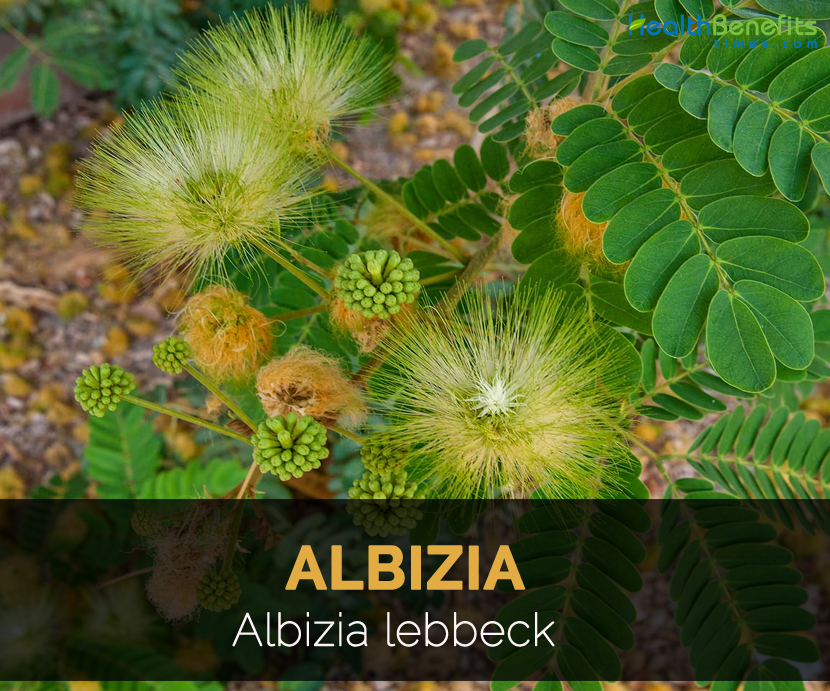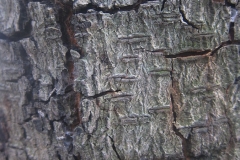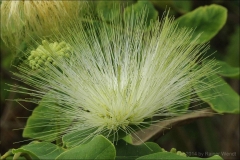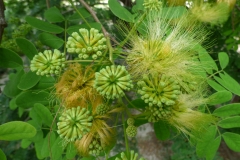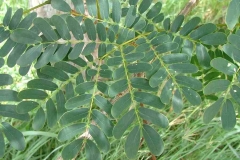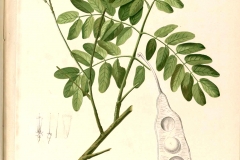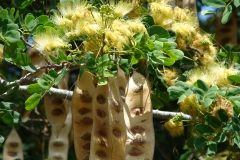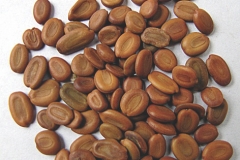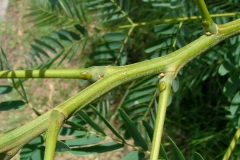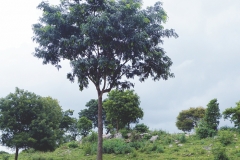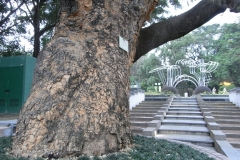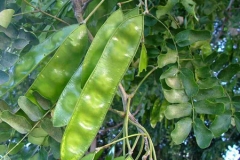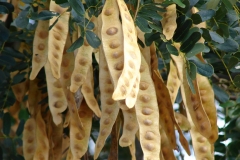Albizia lebbeck grows to the height of 18-30 m with a trunk of 50 cm to 1 m in diameter. The tree has dark brown to greenish black, rough having longitudinal or transverse fissures on outer surface and inner surface is whitish with fine longitudinal stations. The heartwood is dark brown marked with dark and white shades and the sapwood is white or yellowish white. Leaves are bipinnate having 8 to 18 leaflets. Flowers are greenish yellow and stalked. The flowering and fruiting starts from April to June.
Leaves have tremendous medicinal and nutritional value. Leaves possess saponin, cardiac glycoside and tannin. It acts as astringent and used for boils, coughs, flu, lung problems and gingivitis. The bark is used for treating inflammation and fish poison.
Plant description
Albizia lebbeck is an unarmed and deciduous tree which is 20 m (65 ft.) tall with round, spreading or umbrella-shaped crown and pale grey to dark brown, rough and irregularly cracked bark. Leaves are alternate with 2 to 5 pairs of pinnae. Each pinna has 3-10 pairs of leaflets which are elliptic to oblong, asymmetrical at base, dull green above, paler green below and about 2-4 cm (1-2 in) long. Flowers are showy and rounded clusters near stem tips, cream or yellowish-white and 5-6 cm (2-2.5 in) across. Each flower has long and numerous stamens. Flowers are followed by flat and linear pod about 30 cm (1 ft) long with numerous seeds.
Health Benefits of Albizia lebbeck
- Curtails anxiety and stress
Albizia lebbeck has active components such as isoquercetin, quercetin, polyphenols and saponins that have strong impact on hormonal and nervous system in the human body. As a mild sedative, it wipes out the feelings of anxiety and stress. Albizia is helpful for people with chronic stress hormones in the body as it relaxes the mind.
- Helps with depression symptoms
Albizia lebbeck promotes mood by rebalancing hormones in the body and soothes nervous system that complicates the hormone levels. It is helpful for people with feelings of suicidal tendencies, experiencing irrational anger or thoughts. In ancient medicinal cultures, this herb assist the one to get peace.
- Sound sleep
A decoction made with Albizia lebbeck is helpful for people with insomnia or sleeplessness. Besides soothing mind and nerves, it calms the body and provides long lasting and restful sleep.
- Respiratory ailments
Albizia lebbeck helps the people with allergies, asthma and chronic respiratory conditions by reducing inflammation in sinuses and tracts. It also lowers the impulse to cough or wheeze. It enhance respiratory health and speeds up recovery time.
- Acts as antioxidant
Antioxidants present in Albizia lebbeck helps to eliminate free radicals in the body by scavenging harmful byproducts before mutation of cells or causing health problems.
- Healthy skin
Its bark and leaves possess antioxidant properties that acts outside the body and prevents cutaneous conditions such as blemishes, rashes, psoriasis, acne and wounds due to its antioxidant and anti-inflammatory properties that soothes the affected areas and lowers the appearance of irritation and blemishes.
- Digestive health
Powdered Albizia lebbeck helps people with gastrointestinal problems. It binds water and food material by speeding up digestion process and keeps bowel movements regular.
https://www.youtube.com/watch?v=uSyVTWrNdl8
Traditional uses
- Bark is used as the treatment for boils and dysentery.
- Seeds and leaves are helpful of ophthalmia.
- In India, leaves are used for night blindness; bark is used for dysentery and diarrhea; flowers are used for swellings, carbuncles, boils; seeds are used for diarrhea, piles and gonorrhea and roots are used for spongy and ulcerated gums.
- In Indo-China, seeds and bark are used for diarrhea, dysentery, hemorrhoids; flowers are applied as poultice to boils.
- Take it internally for piles.
- Seeds powder is used for treating scrofula.
- Use it to treat ringworms or wounds (wash the affected areas), bronchitis, leucorrhoea, helmenth infection, paralysis, leprosy and other genital diseases.
- The whole part is used to treat bites or stings from venomous animals.
- Leaves are used for ulcer, syphilis, cough, cold and respiratory problems.
- Bark is helpful to cure blood diseases, excessive perspiration, leucoderma, bronchitis, inflammation, toothache and strengthen gums or teeth.
- Roots are used to alleviate spasms and vitalize cardiovascular system.
- Apply the seed oil topically to cure leucoderma.
- Use the seeds to cure diarrhea, piles and scrofulous swellings.
- For skin problems and blood purification, mash 10 gm of Albizia lebbeck bark in 200 ml of water (soak it overnight) and filter it and drink this water to eliminate toxins from the body.
- For eye problems, grind Albizia lebbeck leaves and using the cloth tie it on affected area. Let it remain for few minutes.
- To treat ear pain, extract the juice of Albizia lebbeck leaves and put few drops in ear.
- Mix the Albizia lebbeck leaves (fried in ghee) with honey and take it as a cure for cough.
- Take ½ gram of Albizia lebbeck seeds for dysentery and diarrhea.
- For piles, apply the grinded Albizia lebbeck seeds to the affected area. It helps to dry warts in piles.
- Boil 200 ml of water with 10 gm of Albizia lebbeck bark till the volume reduces to one fourth. Strain it and drink for liver associated problems and ascites.
- Grind Albizia lebbeck leaves and mix it with honey and water. Drink this solution to treat urinary problems.
- Mix the Albizia lebbeck flower juice with black pepper and juice. Use this decoction for nasal instillation or oral medication for snake bites.
- The fragrance of flowers treats migraine and headache.
- Leaves and flower juice is used to eliminate intestinal worms.
Dosage
- Bark: 5-7 g
- Seed: 1-2 g
- Leaves: 12 g
Precautions
- Consult the health practitioner before using the herb to treat any health ailments.
- Pregnant women should avoid this herb as it has blood circulating effects.
References:
https://www.itis.gov/servlet/SingleRpt/SingleRpt?search_topic=TSN&search_value=26450#null
http://www.hear.org/pier/species/albizia_lebbeck.htm
https://npgsweb.ars-grin.gov/gringlobal/taxonomydetail.aspx?id=2140
https://pfaf.org/user/Plant.aspx?LatinName=Albizia+lebbeck
https://www.fleppc.org/ID_book/albizia%20lebbeck.pdf
http://www.worldagroforestry.org/treedb/AFTPDFS/Albizia_lebbeck.PDF
http://www.ijirset.com/upload/2017/september/148_54_Ambika.pdf
http://tropical.theferns.info/viewtropical.php?id=Albizia+lebbeck
https://pdfs.semanticscholar.org/49a7/917e2f8ba313d68f5b89f6c8844ed81bba66.pdf
https://www.bimbima.com/ayurveda/medicinal-use-of-shirishalbizia-lebbeck/1283/
https://www.organicfacts.net/health-benefits/herbs-and-spices/albizia.html
https://www.athayurdhamah.com/about-ayurveda/shirish
Comments
| Albizia Quick Facts | |
|---|---|
| Name: | Albizia |
| Scientific Name: | Albizia lebbeck |
| Origin | Native to tropical Africa, Asia and northern Australia and widely planted in throughout the tropics |
| Colors | Pale straw to light brown |
| Shapes | Narrow-oblong, 15-26 x 3-5 cm |
| Name | Albizia |
|---|---|
| Scientific Name | Albizia lebbeck |
| Native | Native to tropical Africa, Asia and northern Australia and widely planted in throughout the tropics |
| Common/English Name | East Indian walnut, koko, fry wood, lebbek tree, lebbek, siris tree, lebbekboom, women’s tongue tree, ebano oriental, lingua de mulher, coraçao de negro, lingua de sogra |
| Name in Other Languages | Afrikaans: lebbekboom; Arabic: dign el basha, daqn el basha, tukhme siris (توكهم سيريس), lebekh (labakh) (لَبَخ ), lebekh lahmar ( لبخ احمر); Assamese: kothia koroi, siris; Bengali: shirish (শিরীষ), sirish; Burmese: anya-koko, mai- kokko, kokko, tama-kai, zo-fek; Carolinian: schepil kalaskas; Chamorro: kalaskas, trongkon kalaskas, mamis, trongkon-mames, tronkon mames; Chinese: kuo jia he huan (阔荚合欢), Dàyè héhuān (大葉合歡); Chinese: kuo jia he huan; Danish: tibettræ; English: Woman’s tongue, Broome raintree, Ebano-oriental, Indian siris, Rain Tree; Fijian: vaivai ni vavalagi, vaivai, vaivai ni vavalangi; French: acacia d’égypte, ebénier d’orient, bois noir, faux mendoravina, vieille fille; German: lebachbaum, andamanen-koko, ostindischer nußbaum; Gujarati: shirish (શિરીષ); Hebrew: אלביציה צהובה; Hindi: kalio siras, charas, sarasa (saras) (सरस), siris (सिरिस), śirīṣa (sirisa, shirish) (शिरीष); Italian: albizia Indiana; Japanese: biruma nemu (ビルマネム), biruma goukan (ビルマゴウカン); Kannada: sirisa (ಸಿರೀಸ); Khmer: chreh; Laotian: kar sae, ka’sê, ka sae, mai thone; Malagasy: fany, bonara; Malay: batai batu, batai, kitoke, oriang, kungkur, tarisi, tekik; Malayalam: chelinge, nemnēnivāka, kattuvaka, nenneni, nenmeenivaaka (നെന്മേനി വാക), വാക (vaaka vaka); Mangarevan: paina; Maori (Cook Islands): ‘arapitia; Marathi: shiras (शिरस), shirish (शिरीष); Myanmar: anya-kokk, kokko; Nepalese: kalo siris (कालो शिरीष); Oriya: tiniya, thingri; Portuguese: coração-de-negro, língua-de-mulher, ébano-oriental, língua-de-sogra; Russian: al’bitsiia lebbek (альбиция леббек), mimoza lebbek (мимоза леббек), shirisha (шириша);. Samoan: tamaligi; Sanskrit: andhula (अंधुल), bhandika, barhapushpa, bhaṇḍī (भंडी), bhaṇḍīra (bhandira) (भंडीर), dalāḍhaka (daladhaka) (दलाढक), kālā sirasa (kala sirasa) (काला सिरस), kaliṅga (कलिंग), kapītana (कपीतन), karṇapūra (karnapura) (कर्णपूर), madhupuṣpa (मधुपुष्प), mūrdhapuṣpa (murdhapushpa) (मूर्धपुष्प), (mr̥dupuṣpa) mridupushpa (मृदुपुष्प), (lōmaśa puṣpa) lomasha pushpa (लोमश पुष्प), plavaga (प्लवग), pratyaṅgirā (pratyangira) (प्रत्यंगिरा), saptabhadra (सप्तभद्र), śirīṣa (shirisha) (शिरीष), sirīsa (सिरीस), śuka druma (शुक द्रुम), (śuka puṣpa) shuka pushpa (शुक पुष्प), śyāma sundara (shyama sundara) (श्याम सुंदर ), svarṇapuṣpaka (svarnapushpaka) (स्वर्णपुष्पक), vipra (विप्र); Sinhalese: suriya mara, mara, vakai siridam ; Spanish: acacia chachá, algarroba de olor, amor plantónico, aroma fracesca, cabellos de ángel, baile de caballero, canjuro, lengua viperina, lengua de mujer, mata-rato; Sundanese: tarisi, kitoke; Tagalog: langil, aninapala; Tahitian: amurumura; Tamil: adukkavagai, kona, atukkuvakai, nattu vahai, vagai (வாகை), vaivai ni vavalagi, vageri, vakai, vel venkai (வெள்வேங்கை); Telugu: baagichettu, dirisanamu, billa vaara, dorisena (దోరిసెన), peddadirisanamu; Thai: dtôn pá yaa gà bùk ต้นพญากะบุก (ต้นพะยากะบุก), kagoh (คะโก), ka seu (กะ ซึก), ma kaam kohk (มะขามโคก), marum pa ( มะรุมป่า), préuk (phruek) (พฤกษ์); Tongan: kāsia; Urdu: saras (سرس), sareenh (سرینھ); Vietnamese: lim xanh, bô kêt tây, trât; Yapese: ngumormingobchey, gumorningabchey |
| Plant Growth Habit | Deciduous, unarmed tree |
| Plant Size | 20 m (65 ft) tall |
| Bark | Rough, gray-brown |
| Leaf | Bipinnate |
| Flowering Season | September to October |
| Flower | 5-6 cm (2-2.5 in) across, cream or yellowish-white |
| Pod shape & size | Narrow-oblong, 15-26 x 3-5 cm |
| Pod color | Pale straw to light brown |
| Seed | Brown, flat, orbicular or elliptic, 8-10 x 6-7 mm |


